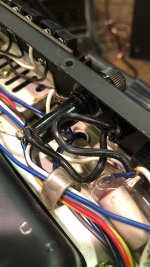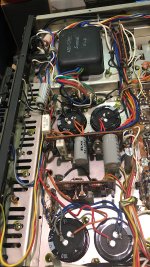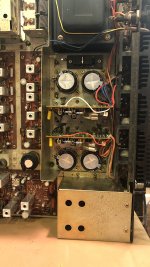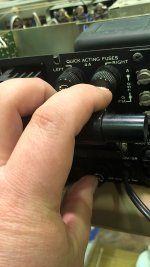Honestly I don’t understand purpose of this board. It supplied fifth capacitor. 36dc on it. View attachment 877874
That is the low voltage supply, which powers most of the circuit other than the power amplifier section.
The two 4A supply fuses are NOT on the back panel. These are internal fuses,
located either on a pcb, or mounted somewhere inside (top or bottom) on the metal chassis.
However, since the DC voltages on the two output blocking capacitors seem normal
at 38VDC each, the 76VDC suppies are reaching the power amplifiers, and both of the fuses
must be ok. You can forget about those for now. The 4A fuses each connect one of the 68V
power supplies to the power amplifier circuit board.
Now make a list of all of the remaining electrolytic capacitors for replacement, from the service manual.
located either on a pcb, or mounted somewhere inside (top or bottom) on the metal chassis.
However, since the DC voltages on the two output blocking capacitors seem normal
at 38VDC each, the 76VDC suppies are reaching the power amplifiers, and both of the fuses
must be ok. You can forget about those for now. The 4A fuses each connect one of the 68V
power supplies to the power amplifier circuit board.
Now make a list of all of the remaining electrolytic capacitors for replacement, from the service manual.
Last edited:
Not likely, but unimportant for now. They must be ok, if indeed they are there.
The amplifier's output coupling capacitors are blocking the correct 38VDC,
so the 76VDC is reaching the power amplifier board.
The amplifier's output coupling capacitors are blocking the correct 38VDC,
so the 76VDC is reaching the power amplifier board.
Last edited:
The two 4A supply fuses are NOT on the back panel. These are internal fuses,
located either on a pcb, or mounted somewhere inside (top or bottom) on the metal chassis.
However, since the DC voltages on the two output blocking capacitors seem normal
at 38VDC each, the 76VDC suppies are reaching the power amplifiers, and both of the fuses
must be ok. You can forget about those for now. The 4A fuses each connect one of the 68V
power supplies to the power amplifier circuit board.
Now make a list of all of the remaining electrolytic capacitors for replacement, from the service manual.
The Sansui 5000's have three fuses.
One is for the AC input.
Two are for the B+ feeds to the amp boards.
Look, and you'll clearly see them.
The Sansui 5000's have three fuses.
One is for the AC input.
Two are for the B+ feeds to the amp boards.
Look, and you'll clearly see them.
Can you see them in pictures I posted?
They are all on the rear panel if you look.
Man have I looked. I feel stupid right now.rear panel where ac sockets located?
That's them. You said those were speaker fuses earlier, but they're not.
A DC power supply fuse would normally be internal, but these are mounted on the rear panel.
Apparently they blow enough that they had to be made easy access by the consumer.
A DC power supply fuse would normally be internal, but these are mounted on the rear panel.
Apparently they blow enough that they had to be made easy access by the consumer.
That's them. You said those were speaker fuses earlier, but they're not.
A DC power supply fuse would normally be internal, but these are not.
Apparently they blow enough that they had to be made easy access.
That how they’ve been referred in another thread I looked before. Sorry for confusion. I’m glad there no more fuses in this thing. All 3 tested good. Not just visually confirmed but with DMM.
That how they’ve been referred in another thread I looked before. Sorry for confusion.
I’m glad there no more fuses in this thing. All 3 tested good. Not just visually confirmed but with DMM.
You ought to post a correction in that thread, it's a pretty serious error.
It could even lead to someone being shocked by the 68VDC that they thought
was a perfectly safe speaker fuse.
Last edited:
Voltages you describe is about right. 76 on first two big and 36 on second pair. There 3 fuses 2 for speakers and only one for power. All 3 measured fine.
I can’t edit original post. 2 4A fuses not for speakers but power boards. They have dangerous voltages on them be aware.
The two amp power fuses are also used to determine idle current.
Removal of the fuse, and measuring mA across fuse holder should be within spec as posted in service manual.
Been there many times.
I can't tell you how many 5000's I've had on the bench over the years.
Removal of the fuse, and measuring mA across fuse holder should be within spec as posted in service manual.
Been there many times.
I can't tell you how many 5000's I've had on the bench over the years.
- Home
- Amplifiers
- Solid State
- amplifier output weak and distorted.



